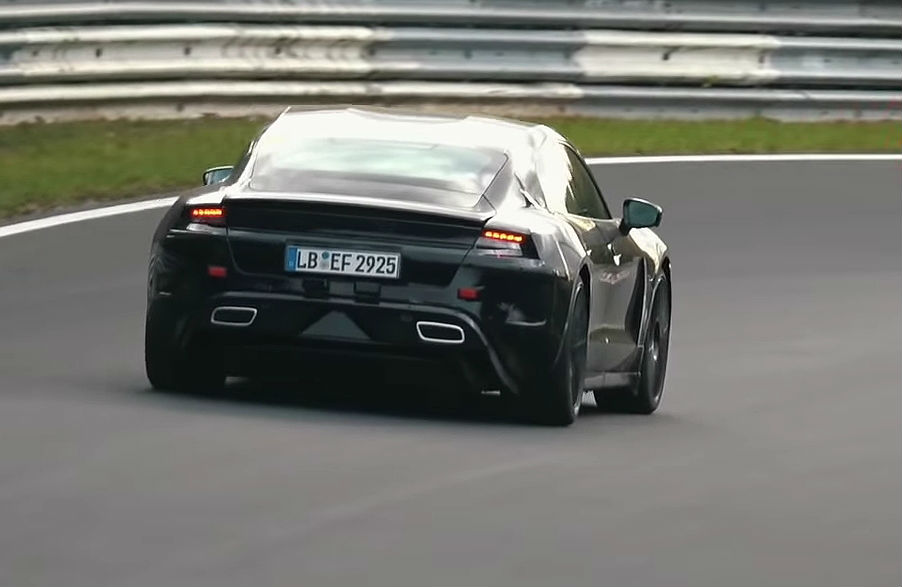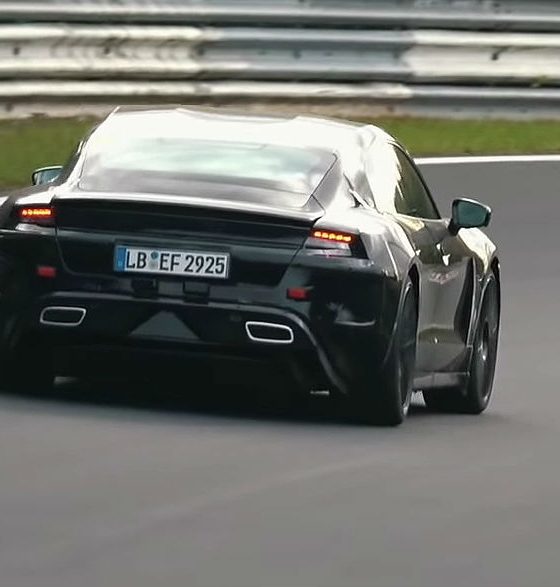

News
Multiple Porsche Taycan prototypes rip through Nurburgring for track testing
German carmaker Porsche appears to be putting the pedal to the metal with regards to the Taycan’s track capabilities, with multiple pre-production prototypes recently being spotted on the Nurburgring. As could be seen in a video taken earlier this month, several of Taycan’s test mules were spotted taking on the iconic track’s turns and straights in true Porsche fashion.
The video, which was taken by auto enthusiast Automotive Mike, shows at least seven Taycan prototypes being track tested on the Nurburgring. Based on clips of the vehicles, particularly the way some prototypes accelerated after navigating a turn, Porsche seems to be refining and testing the track capabilities of the Taycan’s different variants. While all of the Taycan test mules featured impressive acceleration as they hugged the track very well, some of the prototypes seemed to have slight differences in terms of performance.
The prototype fitted with the LB EF 2925 plate, for one, seemingly featured electric motors that were a bit more audible than the other test mules, as seen in 0:31 in the video. The prototype with the LB EF 923 license plate, on the other hand, almost appeared like it was moving in a more deliberate manner (2:04 in the video). While these differences might simply be due to the varying driving styles of the Taycan prototypes’ drivers, the non-uniform behavior of the test mules could also correspond to the different, upcoming performance trims of Porsche’s first all-electric car.
Porsche, after all, has not announced the specific price of the vehicle, though the Taycan’s model-line director, Rober Meier, noted to Automotive News that the company is expecting a price “somewhere between a Cayenne and a Panamera.” This means that while the Taycan would likely start at $75,000 (considering that the Cayenne starts at $66,000 and the Panamera starts at $85,000), there will certainly be versions of the vehicle that feature more performance for a higher price.
The continuous track testing of the Taycan test mules in the Nurburgring shows Porsche’s dedication in releasing an electric car capable of extended high-speed driving. Earlier this year, Porsche VP of Product Line BEV Stefan Weckbach noted that the Taycan (dubbed the Mission E sedan at the time), would be a track-capable alternative to the Model S, which is impressive in straight line races but handicapped in closed circuits. Porsche also promoted the Taycan as a vehicle that would have a “soul,” just like the company’s other cars like the iconic 911.
Porsche has released the specs and features of the Taycan, with the legacy carmaker stating that the vehicle would be fitted with two permanently excited synchronous motors (PSM) that produce a combined 600 hp (440 kW), allowing the electric car to accelerate from 0-60 mph in 3.5 seconds and achieve a top speed of 155 mph. The vehicle is also equipped with an 800-volt battery, which gives the car 310 miles of range per charge. Porsche has further noted that one of the Taycan’s key features would be its charging speed, which could replenish 248.5 miles worth of range in roughly 15 minutes, thanks to a 350 kW charging system.
Pre-orders for the Taycan have been opened in the United States, and so far, Porsche has stated that the reception to the upcoming all-electric vehicle has been very positive. The Taycan is expected to enter production sometime in 2019.
Watch Automotive Mike‘s sighting of the Porsche Taycan prototypes in the video below.

Elon Musk
Elon Musk’s X will start using a Tesla-like software update strategy
The initiative seems designed to accelerate updates to the social media platform, while maintaining maximum transparency.

Elon Musk’s social media platform X will adopt a Tesla-esque approach to software updates for its algorithm.
The initiative seems designed to accelerate updates to the social media platform, while maintaining maximum transparency.
X’s updates to its updates
As per Musk in a post on X, the social media company will be making a new algorithm to determine what organic and advertising posts are recommended to users. These updates would then be repeated every four weeks.
“We will make the new 𝕏 algorithm, including all code used to determine what organic and advertising posts are recommended to users, open source in 7 days. This will be repeated every 4 weeks, with comprehensive developer notes, to help you understand what changed,” Musk wrote in his post.
The initiative somewhat mirrors Tesla’s over-the-air update model, where vehicle software is regularly refined and pushed to users with detailed release notes. This should allow users to better understand the details of X’s every update and foster a healthy feedback loop for the social media platform.
xAI and X
X, formerly Twitter, has been acquired by Elon Musk’s artificial intelligence startup, xAI last year. Since then, xAI has seen a rapid rise in valuation. Following the company’s the company’s upsized $20 billion Series E funding round, estimates now suggest that xAI is worth tens about $230 to $235 billion. That’s several times larger than Tesla when Elon Musk received his controversial 2018 CEO Performance Award.
As per xAI, the Series E funding round attracted a diverse group of investors, including Valor Equity Partners, Stepstone Group, Fidelity Management & Research Company, Qatar Investment Authority, MGX, and Baron Capital Group, among others. Strategic partners NVIDIA and Cisco Investments also continued support for building the world’s largest GPU clusters.
News
Tesla FSD Supervised wins MotorTrend’s Best Driver Assistance Award
The decision marks a notable reversal for the publication from prior years, with judges citing major real-world improvements that pushed Tesla’s latest FSD software ahead of every competing ADAS system.

Tesla’s Full Self-Driving (Supervised) system has been named the best driver-assistance technology on the market, earning top honors at the 2026 MotorTrend Best Tech Awards.
The decision marks a notable reversal for the publication from prior years, with judges citing major real-world improvements that pushed Tesla’s latest FSD software ahead of every competing ADAS system. And it wasn’t even close.
MotorTrend reverses course
MotorTrend awarded Tesla FSD (Supervised) its 2026 Best Tech Driver Assistance title after extensive testing of the latest v14 software. The publication acknowledged that it had previously criticized earlier versions of FSD for erratic behavior and near-miss incidents, ultimately favoring rivals such as GM’s Super Cruise in earlier evaluations.
According to MotorTrend, the newest iteration of FSD resolved many of those shortcomings. Testers said v14 showed far smoother behavior in complex urban scenarios, including unprotected left turns, traffic circles, emergency vehicles, and dense city streets. While the system still requires constant driver supervision, judges concluded that no other advanced driver-assistance system currently matches its breadth of capability.
Unlike rival systems that rely on combinations of cameras, radar, lidar, and mapped highways, Tesla’s FSD operates using a camera-only approach and is capable of driving on city streets, rural roads, and freeways. MotorTrend stated that pure utility, the ability to handle nearly all road types, ultimately separated FSD from competitors like Ford BlueCruise, GM Super Cruise, and BMW’s Highway Assistant.
High cost and high capability
MotorTrend also addressed FSD’s pricing, which remains significantly higher than rival systems. Tesla currently charges $8,000 for a one-time purchase or $99 per month for a subscription, compared with far lower upfront and subscription costs from other automakers. The publication noted that the premium is justified given FSD’s unmatched scope and continuous software evolution.
Safety remained a central focus of the evaluation. While testers reported collision-free operation over thousands of miles, they noted ongoing concerns around FSD’s configurable driving modes, including options that allow aggressive driving and speeds beyond posted limits. MotorTrend emphasized that, like all Level 2 systems, FSD still depends on a fully attentive human driver at all times.
Despite those caveats, the publication concluded that Tesla’s rapid software progress fundamentally reshaped the competitive landscape. For drivers seeking the most capable hands-on driver-assistance system available today, MotorTrend concluded Tesla FSD (Supervised) now stands alone at the top.
News
Elon Musk’s Grokipedia surges to 5.6M articles, almost 79% of English Wikipedia
The explosive growth marks a major milestone for the AI-powered online encyclopedia, which was launched by Elon Musk’s xAI just months ago.

Elon Musk’s Grokipedia has grown to an impressive 5,615,201 articles as of today, closing in on 79% of the English Wikipedia’s current total of 7,119,376 articles.
The explosive growth marks a major milestone for the AI-powered online encyclopedia, which was launched by Elon Musk’s xAI just months ago. Needless to say, it would only be a matter of time before Grokipedia exceeds English Wikipedia in sheer volume.
Grokipedia’s rapid growth
xAI’s vision for Grokipedia emphasizes neutrality, while Grok’s reasoning capabilities allow for fast drafting and fact-checking. When Elon Musk announced the initiative in late September 2025, he noted that Grokipedia would be an improvement to Wikipedia because it would be designed to avoid bias.
At the time, Musk noted that Grokipedia “is a necessary step towards the xAI goal of understanding the Universe.”
Grokipedia was launched in late October, and while xAI was careful to list it only as Version 0.1 at the time, the online encyclopedia immediately earned praise. Wikipedia co-founder Larry Sanger highlighted the project’s innovative approach, noting how it leverages AI to fill knowledge gaps and enable rapid updates. Netizens also observed how Grokipedia tends to present articles in a more objective manner compared to Wikipedia, which is edited by humans.
Elon Musk’s ambitious plans
With 5,615,201 total articles, Grokipedia has now grown to almost 79% of English Wikipedia’s article base. This is incredibly quick, though Grokipedia remains text-only for now. xAI, for its part, has now updated the online encyclopedia’s iteration to v0.2.
Elon Musk has shared bold ideas for Grokipedia, including sending a record of the entire knowledge base to space as part of xAI’s mission to preserve and expand human understanding. At some point, Musk stated that Grokipedia will be renamed to Encyclopedia Galactica, and it will be sent to the cosmos.
“When Grokipedia is good enough (long way to go), we will change the name to Encyclopedia Galactica. It will be an open source distillation of all knowledge, including audio, images and video. Join xAI to help build the sci-fi version of the Library of Alexandria!” Musk wrote, adding in a later post that “Copies will be etched in stone and sent to the Moon, Mars and beyond. This time, it will not be lost.”








